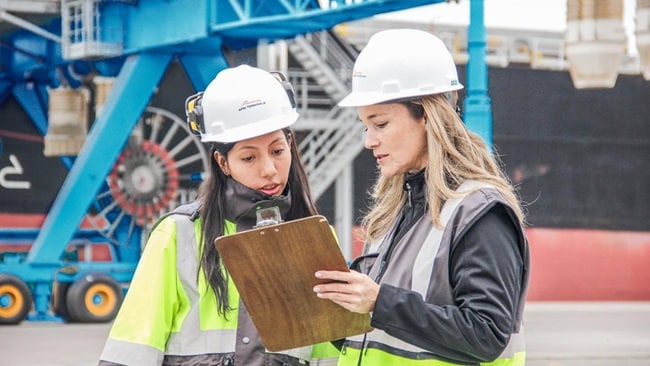Summary
Climate change is making logistics riskier than ever. Extreme weather, such as hurricanes, floods, and droughts, is becoming more frequent and severe. These events can damage infrastructure, disrupt production, and cause costly delays across supply chains. “Climate change doesn't respect borders,” says Andrew Forsyth, the UK-based head of climate resilience and sustainability for Zurich Resilience Solutions. This means that no matter where disruptions begin, their ripple effects can be felt throughout global logistics networks.
In this article, we will explore:
- Severe weather as a top predicted disruption in 2025 and beyond
- Five ways severe weather impacts supply chains
- How businesses can turn risk into resilience
The rising impact of climate on logistics
Climate change is intensifying extreme weather events, and the ripple effects are being felt across global supply chains. According to the World Meteorological Organization (WMO), there is an 86% chance that at least one year between 2025 and 2029 will exceed 1.5°C above pre-industrial levels, increasing the frequency and severity of climate-related disruptions. This prediction is up six percent from the outlook published in 2024.
The World Economic Forum’s Global Risks Report 2025 also highlights escalating environmental challenges as a top risk facing the world. The report is based on the Global Risks Perception Survey 2024-2025, which gathered insights from over 900 experts worldwide. Since 2006, experts have become more concerned about extreme weather risks. In the latest Global Risks Report, extreme weather is now ranked as the second most likely cause of a global crisis in 2025.
Zera Zheng, Global Head of Business Resilience Consulting at Maersk, recommends that all industries and supply chain leaders watch out for weather disruptions. As she explained during a recent episode of the podcast Beyond the Box, “Europe is already seeing worse than average conditions on the Rhine River. March 2025 was also the warmest on record, with low water levels occurring months earlier than usual. We also anticipate this year it will be warmer and drier in Europe… creating an increase in wildfire risk, especially Portugal, Greece, Spain and Italy.” Zheng says that, on top of these issues, forecasters are predicting a highly active hurricane season in the Atlantic Ocean, with several predicted to become major hurricanes.
Five key ways weather disrupts global supply chains
The WMO predicts that even small increases in global temperature will trigger more heatwaves, heavier rainfall, intense droughts, and the melting of ice sheets and glaciers. Oceans will heat up, and sea levels will continue to rise.
Businesses need to stay ahead of these five potential supply chain disruptions:
- Flooding damages to infrastructure: Torrential rains and rising sea levels can flood roads, ports, and warehouses, halting the movement of goods.
- Heatwaves disrupting landside transportation: Extreme heat can warp rail tracks, degrade road surfaces, and overheat vehicles, causing delays and safety risks.
- Storms and hurricanes delaying shipping: Severe storms can close ports, damage cargo, and disrupt maritime and air freight schedules.
- Droughts affecting waterborne transport: Low water levels in rivers and canals reduce cargo capacity or halt shipping altogether.
- Supply chain volatility from regional climate shocks: Localised climate events (e.g., wildfires, blizzards) can shut down suppliers or create bottlenecks in regions.
The WMO expects global temperatures between 2025 and 2029 to rise 1.2°C to 1.9°C above pre-industrial levels. The Arctic will warm even faster—more than 3.5 times the global average. As a result, frequent and intense weather disruptions are not just possible; they are likely.
The cost of inaction: why preparation matters
Zheng recommends that businesses plan ahead, so they’re ready before disruptions hit. “None of us can predict 100% what will happen in the next second. But what we can do is start to think: what is likely to happen?” She says scenario planning now helps you accelerate your response later. “Remember, time buys options.”
This isn’t just an issue for insurance, operations, or sustainability teams alone. Building organisational resilience to extreme weather events requires involving the right people across the entire organisation, says Forsyth. “It’s important to bring everyone along and not let the focus get lost in semantics.”
Climate risk can be costly, which makes scenario planning now even more imperative. The World Economic Forum cites projections indicating that insured losses from climate-related disasters could reach up to $145 billion in 2025, marking a 6% increase from 2024. Their report “Business on the Edge: Building Industry Resilience to Climate Hazards” provides an assessment of risks and resilience strategies. Another report published in Harvard Business Review also provides a playbook for how companies can proactively prepare for climate risks.
This is on the minds of 570 global logistics decisions makers surveyed for The Logistics Trend Map. Of the survey respondents, 65% cited disruptions due to extreme weather as the biggest driver for improving supply chain visibility. (According to the Trend Map, supply chain visibility was the top trend identified by the survey respondents.) Supply chain visibility has become a cornerstone for improving decision-making and managing disruptions in today’s volatile environment.
Technologies like Internet of things (IoT) and predictive analytics were also highlighted as tools to detect and respond to weather-related disruptions. IoT is reshaping the logistics industry by providing tools and technologies that enhance supply chain visibility, operational efficiency, and connectivity. The Trend Map shows IoT as the second most highly rated trend, with 85% of respondents finding it important. By implementing the right technologies and partnering with integrated logistics providers providing data integrations and resilience models, businesses can ensure that they are well prepared to handle disruptions and maintain smooth operations.
In an era defined by the unpredictable impacts of climate change, integrated logistics partnerships offer a critical advantage: the ability to adapt. By providing access to multiple transit modes and flexible routing, these end-to-end providers can navigate around climate-affected regions and keep goods moving from production to market. The right logistics partner brings resilience, agility, and responsiveness to the supply chain, ensuring operations can pivot quickly when disruptions strike and helping businesses stay ahead of uncertainty.
Be ready to respond to severe weather to go all the way! Discover more with Maersk Logistics Insights, and stay tuned for the latest episode of Maersk’s Beyond the Box podcast, which will dive into the topic of severe weather. For more logistics trends and insights, read and download The Logistics Trend Map.
How can you be ready for anything?
Instability is on the rise, causing logistics to feel the pressure of the constant disruptions. Is your business resilient enough? Do you know what it takes to build resilient supply chains in today's world?
Learn how Maersk can help with logistics resilience.
미래 산업 트렌드에 관한 최신 정보를 원하십니까?
구독 신청을 완료하셨습니다. 환영합니디!
We're sorry, but there was a problem sending your contact request.
Please review the form fields and ensure all required information is provided correctly. If the issue persists, please contact our support team for further assistance.
미래 산업 트렌드에 관한 최신 정보를 원하십니까?
이 양식을 입력하여 구독을 신청하시면 통합 물류에 관한 Maersk의 인사이트를 메일로 받아보실 수 있습니다. 맞춤형 기사를 통해 유용한 정보와 비즈니스 인사이트를 확인해 보세요. 언제든지 구독을 취소할 수 있습니다.
I agree to receive logistics related news and marketing updates by email, phone, messaging services (e.g. WhatsApp) and other digital platforms, including but not limited to social media (e.g., LinkedIn) from A. P. Moller-Maersk and its affiliated companies (see latest company overview). I understand that I can opt out of such Maersk communications at any time by clicking the unsubscribe link. To see how we use your personal data, please read our Privacy Notification.
By completing this form, you confirm that you agree to the use of your personal data by Maersk as described in our Privacy Notification.













